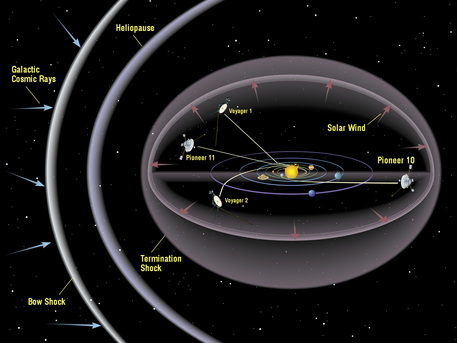Space probes
Exploring the Far Reaches of Space
 © NASA
|
This illustration shows the flight paths of Voyager 1 and 2, and of Pioneer 10 and 11. 'Termination Shock', 'Heliopause' and 'Bow Shock' are three differently defined demarcation lines between our Solar System and interstellar space.
The US space probe Pioneer 10, destination Jupiter, took off from Cape Canaveral on March 3, 1973 on board an Atlas-Centaur launch vehicle. On its way to Jupiter, it also examined the asteroid belt and interplanetary space. As planned, it flew past Jupiter and continued sending data to Earth until January 2003. A service life of 21 months was originally planned – and almost 30 years were achieved.
Unmanned spacecraft journey on into interstellar space
Pioneer 11 is the sister probe of Pioneer 10 and was launched on April 6, 1973. The objective for this probe, weighing just 571 pounds, was to conduct research as it flew past Jupiter and Saturn. Like Pioneer 10, Pioneer 11 arrived at the planets so quickly that slowing it down would have required more fuel than either space probe could possibly have launched with in the first place. Their respective launch vehicles accelerated these two probes to such high speeds that, even today, with no additional propulsion, they continue to fly out beyond the Solar System.
The Voyager probes constituted a newer generation of space probe, and they were launched in 1977 on board Titan rockets - Voyager 2 on August 20, 1977, taking to the skies 16 days before Voyager 1. Voyager 1 blasted off on a shorter flight path to Jupiter, enabling it to overtake Voyager 2 and to become the first of the pair to fly past Jupiter. After Jupiter, Voyager 1 flew on to Saturn, while the orbit chosen for Voyager 2 took it past Saturn, Uranus and Neptune. This made it possible to take the first ever close-up photographs of the two outermost planets in the Solar System.
At the present time, the distance between Voyager 1 and the Sun measures about 111 astronomical units. One astronomical unit (AU) equates to the mean distance between the Earth and the Sun, which measures 92.9 million miles. Voyager 2 is now at a distance of 90 AUs from Earth, Pioneer 10 is at a distance of 99 AUs and Pioneer 11 is at a distance of 79 AUs. The probes are moving away at speeds of between 7 and 10.6 miles per second. This means that, each year, they are covering between 2.5 and 3.5 times the distance from Earth to the Sun.
Source: German Aerospace Center
Space probes
Exploring the Far Reaches of Space
 © NASA
|
This illustration shows the flight paths of Voyager 1 and 2, and of Pioneer 10 and 11. 'Termination Shock', 'Heliopause' and 'Bow Shock' are three differently defined demarcation lines between our Solar System and interstellar space.
The US space probe Pioneer 10, destination Jupiter, took off from Cape Canaveral on March 3, 1973 on board an Atlas-Centaur launch vehicle. On its way to Jupiter, it also examined the asteroid belt and interplanetary space. As planned, it flew past Jupiter and continued sending data to Earth until January 2003. A service life of 21 months was originally planned – and almost 30 years were achieved.
Unmanned spacecraft journey on into interstellar space
Pioneer 11 is the sister probe of Pioneer 10 and was launched on April 6, 1973. The objective for this probe, weighing just 571 pounds, was to conduct research as it flew past Jupiter and Saturn. Like Pioneer 10, Pioneer 11 arrived at the planets so quickly that slowing it down would have required more fuel than either space probe could possibly have launched with in the first place. Their respective launch vehicles accelerated these two probes to such high speeds that, even today, with no additional propulsion, they continue to fly out beyond the Solar System.
The Voyager probes constituted a newer generation of space probe, and they were launched in 1977 on board Titan rockets - Voyager 2 on August 20, 1977, taking to the skies 16 days before Voyager 1. Voyager 1 blasted off on a shorter flight path to Jupiter, enabling it to overtake Voyager 2 and to become the first of the pair to fly past Jupiter. After Jupiter, Voyager 1 flew on to Saturn, while the orbit chosen for Voyager 2 took it past Saturn, Uranus and Neptune. This made it possible to take the first ever close-up photographs of the two outermost planets in the Solar System.
At the present time, the distance between Voyager 1 and the Sun measures about 111 astronomical units. One astronomical unit (AU) equates to the mean distance between the Earth and the Sun, which measures 92.9 million miles. Voyager 2 is now at a distance of 90 AUs from Earth, Pioneer 10 is at a distance of 99 AUs and Pioneer 11 is at a distance of 79 AUs. The probes are moving away at speeds of between 7 and 10.6 miles per second. This means that, each year, they are covering between 2.5 and 3.5 times the distance from Earth to the Sun.
Source: German Aerospace Center






